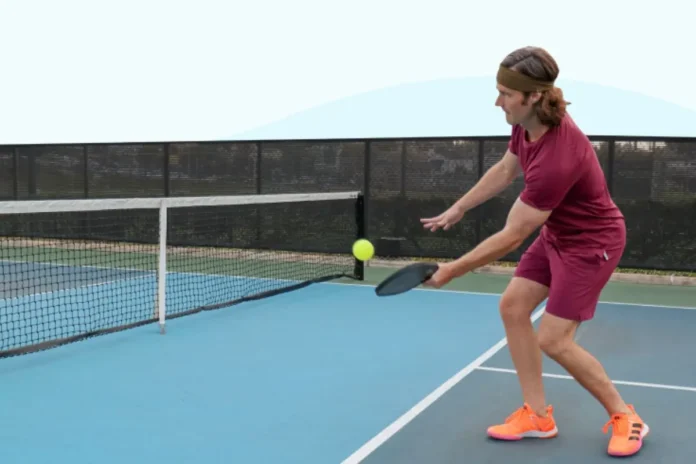How to Absorb Pace in Pickleball: In pickleball mastering the skill of absorbing pace is key to controlling the game. Rather than responding with power, absorbing pace involves softening an opponent’s shot and placing it strategically. This technique helps players regain control, especially in fast exchanges or defensive situations. It’s a vital pickleball skill for players of all levels, whether they’re playing against aggressive opponents or trying to reset a rally.
Understanding Absorbing Pace
Absorbing pace means reducing the speed of your opponent’s shot and returning it with precision instead of power. Instead of hitting the ball back as hard as it comes, players use controlled movements to soften the shot, typically aiming for the kitchen or non-volley zone (NVZ). This allows players to slow down the rally and regain control. This technique is often employed when dealing with fast-paced shots or when stuck in defensive positions.
When to Use Absorbing Pace
The key to absorbing pace is knowing when to use it. Here are several situations where this skill is particularly useful:
-
Facing a “Banger”: When an opponent drives the ball aggressively, absorbing pace can neutralize their power and drop the ball into the kitchen.
-
Defensive Situations: If a player is off-balance or in the transition zone, absorbing the pace provides a chance to reset and regain control.
-
At the Kitchen Line: If an opponent launches a fast attack, absorbing the shot helps keep it low and manageable.
-
In Hands Battles: During rapid volley exchanges, absorbing the pace slows the game, potentially forcing an error or giving the player more time to reposition.
-
Resetting the Point: In fast rallies, absorbing pace helps to slow things down and reset the pace of the game.
Best Shots for Absorbing Pace
Certain shots are more effective when absorbing pace. Here are some of the best options:
| Shot Type | When to Use | How It Works |
|---|---|---|
| Dink | At the kitchen line when facing a hard drive | Softly drop the ball into the NVZ to reduce power |
| Block Volley | During fast exchanges at the kitchen line | Use a firm paddle position to absorb and redirect the shot |
| Reset Drop | In the transition zone or when defending | Soft shot from mid-court, landing in the kitchen |
| Soft Roll Volley | When opponent strikes hard but is out of position | Redirect power with controlled topspin |
| Punch Block | Against aggressive drives with low control needed | Absorb power and keep the ball low with precision |
Each of these shots serves a specific purpose for neutralizing the opponent’s pace, allowing players to regain control and frustrate aggressive opponents.
How to Absorb Pace: Step-by-Step
To successfully absorb pace, follow these key techniques:
-
Grip Pressure: Hold the paddle loosely (4 or 5 on a scale of 10). A tight grip causes the ball to rebound quickly, while a softer grip absorbs the energy.
-
Paddle Positioning: Keep the paddle slightly angled upward and in front of you. Avoid large backswing movements; let the ball come naturally to the paddle.
-
Stable Wrist and Body: Keep your wrist firm but not rigid, and bend your knees slightly to maintain balance. This helps you stay composed while reacting to the ball.
-
Absorb, Don’t Counter: Rather than swinging through the ball, treat the paddle like a cushion, blocking rather than hitting. The goal is to drop the ball in the kitchen.
-
Leg Power: Bend your knees slightly as you meet the ball. This action helps with controlling placement and prevents the ball from popping up.
Observing Your Opponent’s Contact Point
A key to mastering pace absorption is reading your opponent’s contact point. If they strike the ball below net level, expect a softer shot. If they hit from shoulder height or above, prepare for a faster shot and adjust your response accordingly.
Common Mistakes to Avoid
Here are some common errors and tips to avoid them:
-
Gripping Too Tightly: A tight grip causes the ball to rebound too quickly. Aim for a grip pressure of 4 or 5.
-
Swinging Instead of Blocking: Keep your swings short. Focus on blocking and absorbing the shot rather than swinging through it.
-
Standing Too Upright: Bend your knees to maintain balance and control.
-
Hitting the Ball Too High: Keep your paddle slightly angled downward (5-10 degrees) to keep the ball low.
-
Not Watching the Ball: Always track the ball closely to improve your reaction time and accuracy.
Drills to Improve Absorbing Pace
Here are some drills to practice absorbing pace effectively:
-
Wall Absorption Drill: Stand six feet from a wall and gently hit the ball, focusing on soft returns.
-
Partner Blocking Drill: Have a partner hit fast drives at you while you practice absorbing the pace and dropping the ball into the kitchen.
-
Transition Zone Reset Drill: Start at the baseline and practice absorbing the pace while moving forward, placing soft shots into the kitchen to reset the rally.
News in Brief: How to Absorb Pace in Pickleball
Absorbing pace is a key skill in pickleball, allowing players to control fast exchanges and reset rallies. By using pickleball shots like dinks, block volleys, and reset drops, pickleball players can neutralize aggressive opponents and regain control. Mastering this pickleball skill helps players handle high-speed rallies with precision and composure.
ALSO READ: TOLM Foundation Expands Scholarship Efforts with Annual Pickleball Tournament

